Emily Lakdawalla • Dec 21, 2015
Pluto updates from AGU and DPS: Pretty pictures from a confusing world
Pluto is reluctant to give up its secrets. Last week at the American Geophysical Union meeting I attended one oral session and one poster session featuring results from the New Horizons mission, and most of the presentations could be summed up thusly: the data sets are terrific, but there are still a lot of Pluto features that have scientists scratching their heads. Most of the presentations were more descriptive than explanatory, but you have to remember that the New Horizons team doesn't even have half of all their data on the ground yet. They have a good chunk of the highest-resolution images, though, so nearly all of what I'll write about below concerns the surface features that are visible in those images.
Not much of what I saw at AGU differed substantially from what I saw at the Division for Planetary Sciences meeting last month. I never wrote up my notes on Pluto from DPS, so this post includes information from both DPS and AGU.
Let's set the stage with this gorgeous color portrait of Pluto:
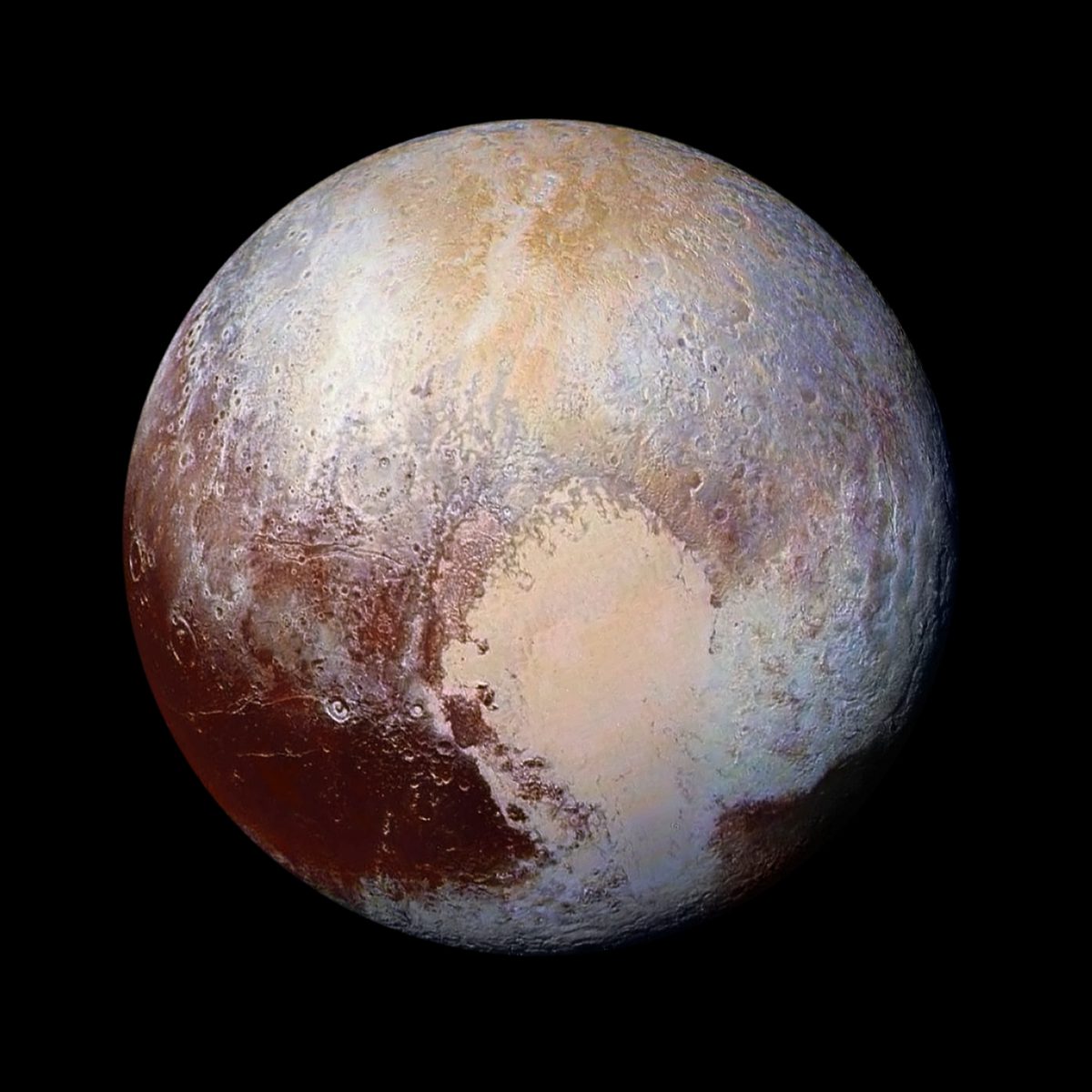
There is a huge variety of types of surfaces on Pluto. That variety relates, in part, to a variety in surface materials on Pluto. The main materials on Pluto are water ice, carbon monoxide ice, nitrogen ice, methane ice, and tholins. At the poster session, I asked geophysicist Bill McKinnon about the properties of these ices. He explained that at the 40-kelvin temperatures that prevail on Pluto, water ice is as strong and solid as rock is on Earth, but the other ices are weaker. Nitrogen and carbon monoxide ices will act very similarly on the surface (and are miscible in each other). The main difference between nitrogen and carbon monoxide on Pluto is that nitrogen is more volatile, and will turn to vapor when heated more quickly than carbon monoxide will. Both have much less strength than water ice, so should flow more readily, much as glacial ice does on Earth. Note that even though they can flow, they are still solid, and the flow we're talking about is relatively slow, in the neighborhood of several centimeters per year. Methane ice can mix into nitrogen and carbon monoxide ices as well, it's less volatile, and may be more rigid. Nitrogen and carbon monoxide ices are both denser than water ice at 40 kelvins, while methane has only half the density of water ice. Tholins are organic solids produced when solar radiation bombards these ices, and are likely the agent that produces reddish stains in various places on Pluto.
In a poster presentation, John Spencer showed that the color of the reddish pole of Pluto is spectrally quite different to the darker reddish terrain near Pluto's equator. He argued from spectral data that the stuff at the pole very likely represents brand-new tholin material, newly concocted by irradiation of ices that accumulated at the north pole during the previous winter. It is quite distinct from the equatorial tholin material, which has probably been exposed to the sun for a very, very long time.
Pluto has fascinating topography. Because everything but water ice flows on Pluto, anywhere you see steep topography, it has to be built of water. It was surprising that Pluto had so much topography, and also surprising how varied it was. Let's begin with the mountains northwest of Sputnik planum:
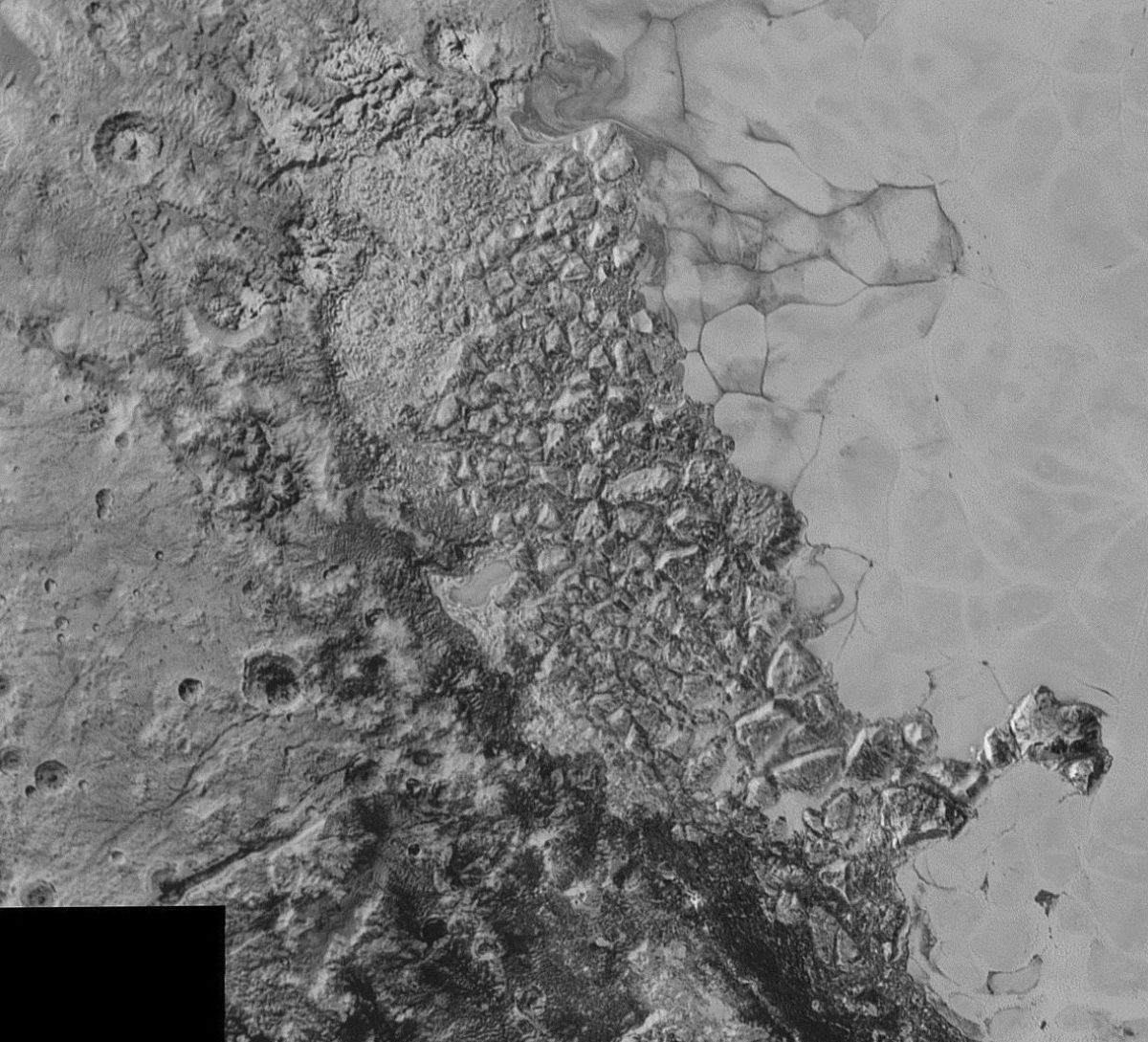
Here's another, more detailed view of part of this terrain:

This enhanced color mosaic combines some of the sharpest views of Pluto that NASA’s New Horizons spacecraft obtained during its July 14, 2015 flyby. The pictures are part of a sequence taken near New Horizons’ closest approach to Pluto, with resolutions of about 77-85 meters per pixel – revealing features smaller than half a city block on Pluto’s surface. Lower resolution color data (at about 630 meters, per pixel) were added to create this new image.
The images form a strip 80 kilometers wide, trending (top to bottom) from the edge of “badlands” northwest of the informally named Sputnik Planum, across the al-Idrisi mountains, onto the shoreline of Pluto’s “heart” feature, and just into its icy plains. They combine pictures from the telescopic Long Range Reconnaissance Imager (LORRI) taken approximately 15 minutes before New Horizons’ closest approach to Pluto, with – from a range of only 17,000 kilometers – with color data (in near-infrared, red and blue) gathered by the Ralph/Multispectral Visible Imaging Camera (MVIC) 25 minutes before the LORRI pictures.
Image: NASA / JHUAPL /SwRIThese look like jumbled broken-up blocks; geologist Jeff Moore referred to them as "chaos." Both Mars and Europa have jumbled-up, broken terrain that is also named "chaos." Chaos generally seems to form where something undermines the crust, causing the stiff material at the surface to break up and collapse. Moore pointed out that water ice would float on nitrogen ice at Pluto, so it's conceivable that the broken-up crust here is riding downhill (toward the right) on a frozen sea of nitrogen. If that's true, it's a puzzle why it would only be happening in this one region of the outer edge of Sputnik planum, and not elsewhere.
South of Sputnik planum are two extremely strange-looking topographic features. They are round and tall and they have deep central pits. Here's a photo of one of them; you can see the other in a New Horizons image release showing their topography.
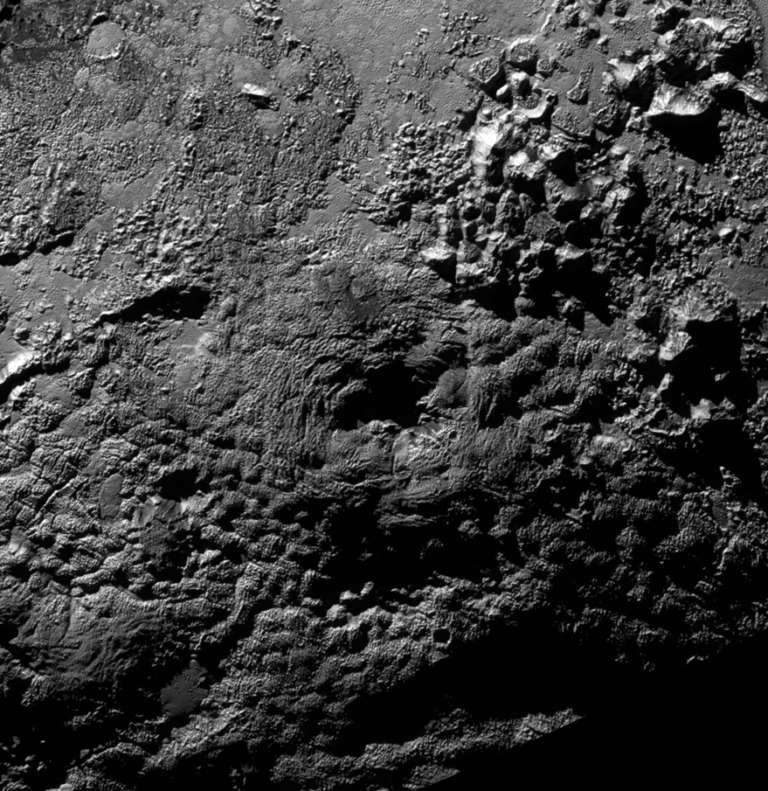
There are two main ways to make round features on planets: impact cratering and volcanism. Jeff Moore was almost sheepish when he introduced the possibility of a volcanic origin for these mountains; he's been a vocal skeptic of volcanism as an explanation for round features on other worlds, notably Titan.
Here's a Plutonian terrain that is truly weird, both for its low, parallel ridges and for the blade-like features that adorn them.
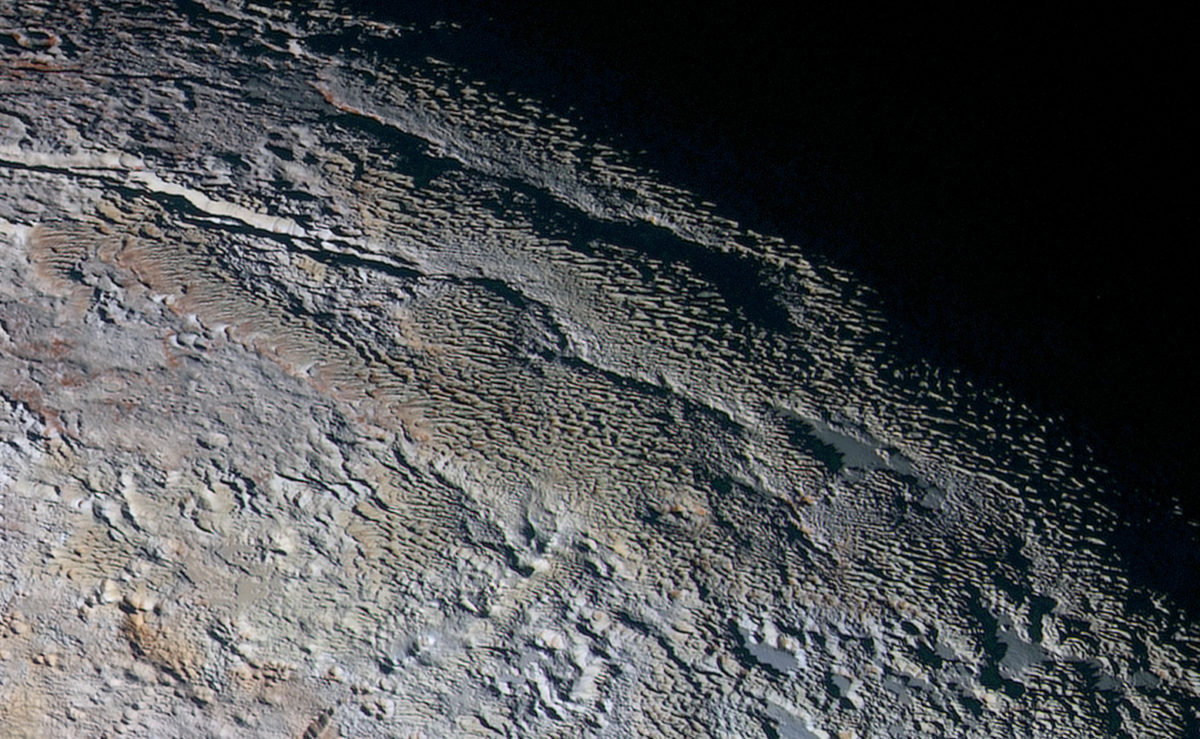
Moore said they might be like penitentes, blades of ice that form in frozen deserts by the sublimation of ice under the influence of the Sun, but if they are penitentes, they are of a scale dramatically larger than is found on Earth. Other possibilities include undermining and collapse, or growth of ridge tops through preferential deposition of volatiles, as happens on Callisto.
One of the few things about Pluto geomorphology that scientists seem very confident about is that there is glacial activity, where ices like nitrogen and carbon monoxide are flowing in the solid state from high places to low places. Glaciers create a variety of diagnostic landforms: they carve U-shaped valleys, they flow around obstacles, and they deposit lateral and terminal moraines. However, Alan Howard pointed out in a talk, you wouldn't expect every glacial feature found on Earth to be found on Pluto. For one thing, because nitrogen ice does not expand as it freezes, you would not expect any features associated with freeze-thaw cycles on Earth to have corresponding features on Pluto. Examples include glacial cirques, the theater-shaped valleys that form at the origins of alpine glaciers; their bowls are carved out when water wets rocks and then freezes and expands, spalling off the rock surface. That wouldn't happen at Pluto.
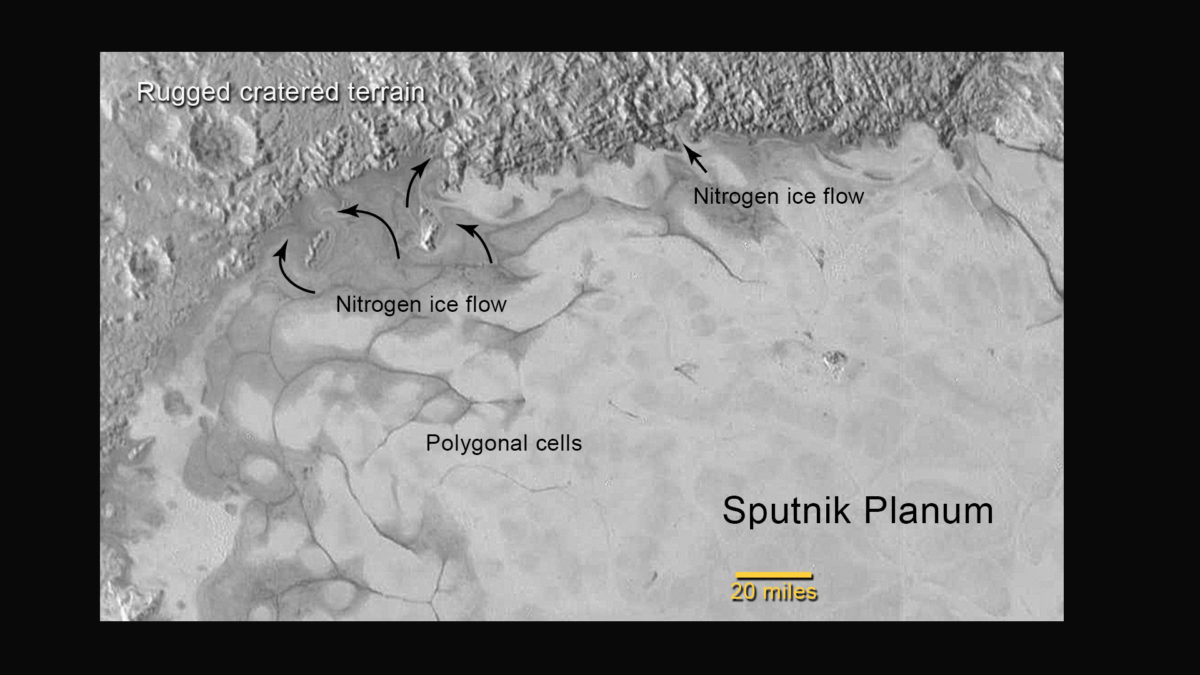
But there isn't just glacial flow happening. Scientists seem to be pretty confident that the polygonal cell-like terrain in the center of Sputnik results from convection within a layer of nitrogen/carbon-monoxide ice. Convection is a way that worlds with warm interiors get rid of heat. Warm material is less dense than cold material; if there's enough heat at depth, then warm material will tend to flow toward the surface, and cold material will sink. Oliver White has now mapped 168 discrete polygon-shaped cells on Sputnik planum. They have a mean diameter of 33 kilometers. Bill McKinnon has modeled the physics of convecting nitrogen ice and determined that the convection cells are typically 10 times wider than they are thick, so that argues for a layer of nitrogen ice within Sputnik that is about 3 or 4 kilometers thick; it's thicker at the middle (where cells are larger) than at the edges. At the surface, the flow is slowest at the centers and edges of polygons, and quickest in between center and edge; McKinnon's maximum predicted flow rates are about 7 centimeters per year. This is comparable to the rate of motion of tectonic plates on Earth -- geologically fast, but slow on human time scales. It's about twice as fast as fingernails grow. If you naïvely apply that flow rate across an entire average-size cell, it would take nearly half a million years for the cell to refresh its surface.
At AGU, Oliver White pointed out a cool feature of the polygonal terrain I hadn't thought about before: little isolated hills that seem to cluster at the borders of cells. White said: "In quite a few instances we see these hills that seem to form chains that coincide with glacial flow paths that come down from mountains. They form clusters that, without exception, always congregate at edges of cells. We may be seeing eroded fragments of highlands crust that evidently is less dense than nitrogen ice, maybe water ice, carried down by glaciers. Once they reach the cellular terrain, they are subject to a convective regime, reach edges and congregate" because they do not sink along with the sinking margins of the convective cells. White argued that their presence is an additional piece of evidence that solid-state convection really is occurring in the cellular terrain.

Another feature of Sputnik is pits within the cellular terrain. Some pits are smaller, some are larger. In many of the cells, there appear to be fewer, smaller pits in the cell centers, and more, larger pits near the cell margins. (See, for example, this image.) That, too, could be evidence for convection: the surface of the cell is youngest at the center, where new material is upwelling, and oldest at the edge, so cell edges have had more time to accumulate pits than cell centers. The pits are probably caused by sublimation of nitrogen ice, White said.
Inside of Sputnik planum, the New Horizons team has so far found not a single conclusive impact crater, indicating its surface is quite young; less than 10 million years old and possibly much younger, Kelsi Singer said. Outside of Sputnik, there are many more craters. She pointed out that one of the newer image releases contains several craters that formed as doublets. This isn't a surprise, since binaries appear to be quite common among Kuiper belt objects. She also pointed out that the same image contains one of the few recognizeable examples of an ejecta blanket around a Plutonian crater -- it surrounds the dark doublet near the center.
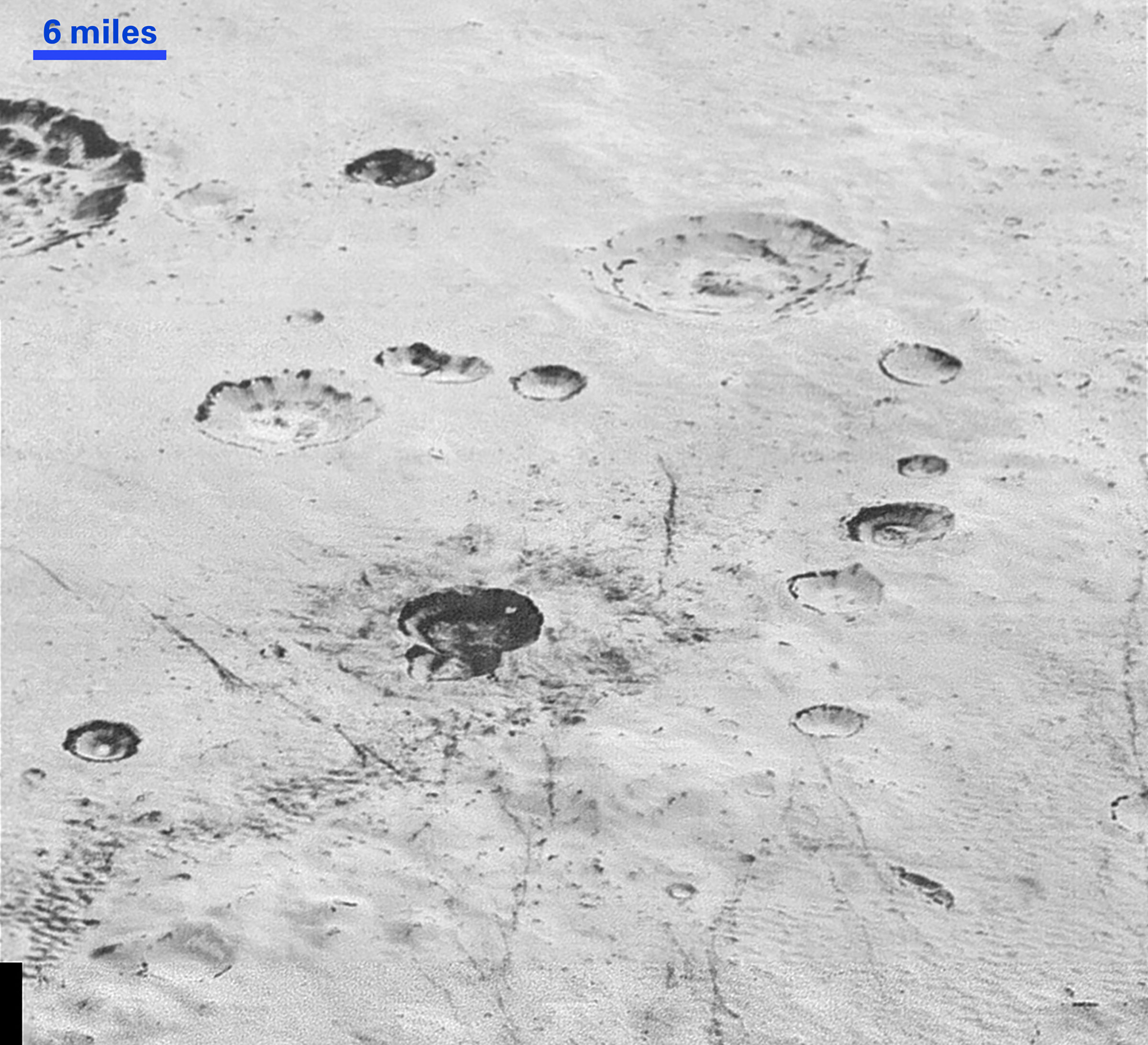
There were two geophysical presentations at DPS -- one a talk by Francis Nimmo, the other a poster by Geoff Collins -- that looked at the long-term evolution of the Pluto system. Nimmo examined the shape of Pluto, looking for any evidence of flattening, and found that no flattening is detectable. Pluto must have been flattened a long time ago, shortly after the Charon-forming impact, when Charon was much closer, so the lack of flattening implies "that Pluto maintained a relatively warm and deformable interior during the bulk of the system's orbital evolution" to its present state. Collins looked at how quickly Charon would have moved out to its current position after the Charon-forming impact. According to his simulations, if Pluto never had an internal ocean, Charon would never have receded as far as it has from Pluto; that is, Charon's current position absolutely requires that Pluto had an ocean at one time. Given an internal ocean, the motion of Charon to its current position would have happened very rapidly, within a million years of the Charon-forming impact.
Finally, here are a few other random tidbits from talks and posters on New Horizons results:
- Simon Porter has new size estimates for the small moons: 16 by 9 by 9 kilometers for Styx; 50 by 40 by 32 for Nix; 17 by 10 by 9 for Kerberos; and 52 x 39 x 10 for Hydra. The first three are pretty well approximated by triaxial ellipsoids; Hydra, not so much. Porter told me he suspects that Kerberos is not actually bi-lobed, but is rather a more ordinary-shaped moon with a dark spot that makes it look like a dumbbell in the New Horizons photo, because the triaxial ellipsoid models its lightcurve pretty well.
- Bill McKinnon reported some of Paul Schenk's work on Sputnik planum topography: the whole thing appears to be a 4-kilometer-deep, smooth-floored basin, elliptical in shape, 1050 by 800 kilometers in extent. Schenk thinks it is an impact crater that was later filled with nitrogen ice.
- The "mountains in a moat" on Charon were originally thought to be places where a heavy load in the form of a mountain was depressing the surface of Charon. But John Spencer reported that that doesn't work geophysically; the moat edges are too sharp. The team now favors an idea that the steep margins of the moat are actually flow fronts, where viscous water-lava was not fluid enough to lap up to the mountain. In general, Charon has a lot of textures on it that the scientists just don't understand. The closest analog to Charon in the solar system appears to be Uranus' moon Ariel. That leads to an intriguing conclusion: since Charon has never experienced tidal heating, maybe tidal heating wasn't necessary to create Ariel's geology, either.
My page of raw New Horizons images is now up-to-date. A note on the New Horizons website says that no further images will be added to the page until January 8. Time for a New Year's break for the team!
Support our core enterprises
Your support powers our mission to explore worlds, find life, and defend Earth. You make all the difference when you make a gift. Give today!
Donate

 Explore Worlds
Explore Worlds Find Life
Find Life Defend Earth
Defend Earth

